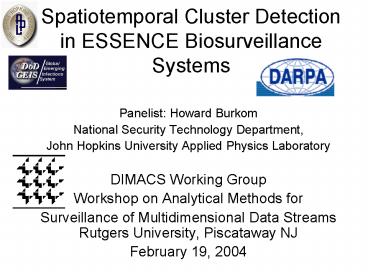Spatiotemporal Cluster Detection in ESSENCE Biosurveillance Systems PowerPoint PPT Presentation
Title: Spatiotemporal Cluster Detection in ESSENCE Biosurveillance Systems
1
Spatiotemporal Cluster Detection in ESSENCE
Biosurveillance Systems
- Panelist Howard Burkom
- National Security Technology Department,
- John Hopkins University Applied Physics
Laboratory - DIMACS Working Group
- Workshop on Analytical Methods for
- Surveillance of Multidimensional Data
StreamsRutgers University, Piscataway NJ - February 19, 2004
2
Problem/Data Context of ESSENCE Surveillance
Systems
Absentee Rates
Sales of OTC Remedies
Hosp ER Admissions
Physician Office Visits
Normalization Analysis Fusion
Counts/Clusters of Statistical Significance
Who? What? Where? When?
Epidemiological Significance
3
Applying Statistical Process Control to Multiple
Data Streams
- Multiplicity from intertwined effects multiple
data sources, regions, strata (syndrome groups,
product groups) - Multiple univariate methods
- Critical issue use individual detector outputs
without getting overwhelmed by multiple testing - Low power for anomalies spread over inputs
- Multivariate methods
- Critical issue need modifications to reduce
alerts due to irrelevant changes in data
relationships - Need to retain power in individual source data
4
Significance Assessment Multiple Univariate
Alerting Algorithms
- Bonferroni bound replace a by a/N
- Alert based on individual outputs (conservative)
- Edgingtons consensus method (1972)
- Combined prob from alg. comb .of N individual
p-values - Z-score approximation
- ( mean(p-values) 0.5 ) / ( 0.2887 / vN )
- Bayes Belief Net
- Originated effort to add sensor data,
intelligence info, - Recently applied to separate algorithm outputs
- Can weight each type of information based on
training data and/or intuition - Configurable to soften thresholds for evidence
accrual
5
Multivariate Alerting Strategies
- Variants of Hotellings T2
- m vector mean est. from current baseline
- S est. of covariance matrix calc. from baseline
- X multivariate (filtered?) data from test
interval - T2 statistic (X- m) S-1(X- m) (Ye et al, 2002)
- Neighbor-regression preconditioning strategy of
Hawkins removal of covariance effects - MEWMA (Lowry), MCUSUM (Crosier,
Pignatiello/Runger) - Numerous strategies, adaptations to Poisson data
- But which is appropriate for multivariate
syndromic data streams? - Can EWMA/Shewhart (or CUSUM/Shewhart) encompass
both point-source bioweapon epicurve and
seasonal endemicgtepidemic outbreak?
6
Detection Challenge faint rise in all 3 data
sets
Respiratory Syndrome Data Counts
Military Dx
Military Rx
Civilian Dx
7
Detection Challenge faint rise in all 3 data
sets
Respiratory Syndrome Data Counts
Lowrys MEWMA Day 4 alert at each FA rate
8
Scan Statistics for Biosurveillance
Scarlet Fever Outbreak Study
Analysis of Claims Data in National Capital Area
ICD9 codes for scarlet fever 034 034.1
10 cases, 5 days p 0.013
15 cases, 12 days p 0.002
11 cases, 7 days p lt 0.001
9
Surveillance combining outpatient visits, OTC
anti-flu sales, school absenteeism
10
Practical Issues in Spatiotemporal Monitoring and
Evaluation
- Control needed for mismatched scales variances
among data sources - To retain power in indiv. sources, gain combined
sensitivity - Difficult to assess delays, relative scales of
effects among separate sources, in both
background signal - Simulation much harder to validate
- If distance matrix is used, it should reflect
proximity according to the epidemiological case
definition - Modifications to reflect plausible demographic
behaviors - The importance of significance testing grows
with the number of sources, especially for
subregions where expected counts are low - More sources gt more small spurious clusters
11
Finding Clusters with Multiple Data Sources
- For candidate cluster J1, the Kulldorff
likelihood ratio is - LR(J1) (O1/E1)O1 ((N-O1) / (N-E1)) (N-O1)
- where O1 number of cases inside J1,
- E1 number of cases outside J1,
- N total case count
- Extension by treating multiple sources as
covariates - O1 SO1k, E1 SE1k, N SNk, for sources
k1,,K - adjusted method problem of adding sources
with mismatched scales, variances - Alternate multisource approach stratified
scan statistic - S log( LR(J1k) ), k1,,K
- reduces chances for a noisy source to overwhelm
others - can cost power to detect faint signal spread
over sources
12
FROC Performance Assessment Adjusted vs
Stratified Multisource Scan Statistics
Prob. Signal-Based Significant Cluster
Prob. Random Background Significant Cluster

